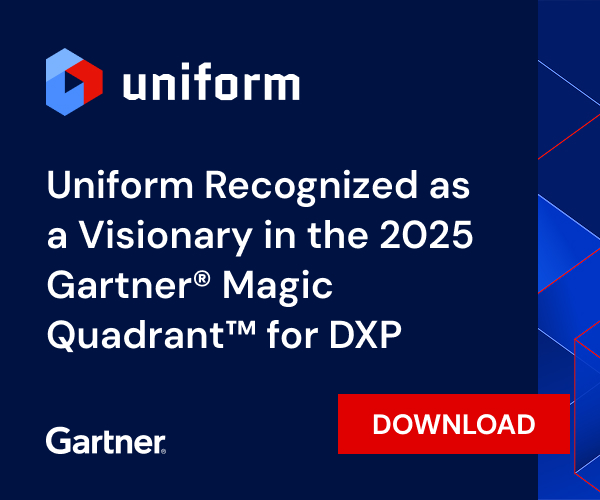Uniform blog/CMS migration: Step-by-step guide to incremental evolution
CMS migration: Step-by-step guide to incremental evolution
CMS migration: Step-by-step guide to incremental evolution
TL;DR
Learn how to migrate from a legacy content management system (CMS) to a modern, composable architecture using an incremental, low-risk approach. Organizations can modernize content operations without downtime or disruption by leveraging Uniform’s no-code integrations and Visual Workspace. The key takeaway: incremental migration enables faster results, reduces risk, and empowers teams to innovate while maintaining business continuity.
Full-scale migrations typically involve substantial risk, extended downtime, and complex coordination across multiple departments. However, there is a better way forward: incremental migration strategies that let businesses modernize their content infrastructure gradually while maintaining operational continuity.
A strategic approach to CMS migration
Incremental migration distills the traditional "rip and replace" methodology into a manageable, step-by-step process. Instead of migrating everything simultaneously, gradually transfer content while maintaining access to existing systems. This approach dramatically reduces risk while enabling continuous operation throughout the transition.
Uniform's composable CMS architecture makes incremental migration particularly effective by supporting federated content throughout the migration. Leverage multiple content sources simultaneously, accessing legacy systems, new content repositories, and more through a unified interface. This flexibility means teams can work with familiar content while building toward the target architecture.
The incremental migration framework
1. Content inventory and mapping
First, inventory content in existing systems (e.g., articles, product pages, media files) and understand how they connect and are used. Next, map out how content should live inside the Uniform CMS, focusing primarily on what drives real business results. Lastly, take this opportunity to remove older content that may be misleading now.
2. Connecting content sources
Uniform's no-code integration framework eliminates the technical barriers that traditionally slow migration projects. Integrate the CMS and other content repositories without custom development work. This multi-source unification streamlines content operations immediately, offering teams access to all content through a single platform.
3. Modeling and validation
Create flexible content types with built-in validations and localization support. Uniform separates content and experience modeling capabilities to enable teams to establish clean content structures that separate content from presentation logic. Enable workflows and approval processes that maintain content governance standards throughout the migration period.
4. Visual experience management
The Uniform Visual Workspace is a command center for building digital experiences by blending content and data from every source. Users can visually edit and preview content regardless of where it's stored, making inline updates without developer intervention. This capability maintains peak productivity while migration work continues in the background.
5. Publishing and scheduling
Scheduled publishing and error validation features ensure smooth content rollout. Manage releases and campaigns confidently, knowing content will go live correctly even when sourced from different systems.
A platform for complex migrations
To significantly shorten migration time, leverage Uniform to deftly navigate the complex mapping and restructuring work while maintaining content quality and preserving critical relationships between pages, media, and metadata.
While traditional migrations average nine months for up to 100 websites, Uniform's no-code approach completes similar projects in an average of three months. That's 3x faster migration speed, eliminating much of the manual work that traditionally extends timelines.
Particular legacy systems require specialized migration tools to handle their unique complexity. Uniform's Siphon eases the heavy lifting by processing and formatting existing content and presentation structures directly into Uniform—a faster migration with less risk of losing essential content relationships or breaking existing URLs.
Essential best practices for migrations
Maintain clean content models using the experience model approach. Separating content and presentation logic prevents the pollution that often occurs when design decisions creep into content structures. Organize components and compositions with editorial workflows in mind, making the authoring experience intuitive and consistent.
Implement granular roles and permissions to secure content editing and publishing across sources. This control becomes especially important when teams access content from multiple systems with varying security models.
Don't overlook optimization opportunities post-migration. Uniform's built-in A/B testing and personalization capabilities can improve performance once content has moved to the new system.
Why incremental migration works
Incremental migration with Uniform reduces risk while accelerating time to market. Rather than months of preparation followed by a high-stakes launch, begin seeing benefits immediately while building toward the complete vision.
This approach enables true marketing autonomy by providing visual content management tools that work across all sources. Meanwhile, developers can focus on innovation rather than maintenance, knowing content operations continue smoothly throughout the transition.
The composable architecture that makes incremental migration possible also future-proofs investments. Solve today's migration challenge and build infrastructure that adapts as needs evolve.
Ready to start your migration journey?
Your current CMS is costing you opportunities every day it stays in place. Uniform's incremental migration approach can have you seeing results in weeks, not months.
Ready to transform your CMS migration from a stressful overhaul into a smooth, strategic advantage? Let's talk. Schedule a personalized migration consultation with our seasoned experts now.
FAQs
Incremental migration is a step-by-step approach to moving content from legacy systems to a new CMS without replacing everything at once.

Uniform Recognized as a Visionary in 2025 Gartner® Magic Quadrant™ for Digital Experience Platforms
Download




.png&w=1080&q=90)
.png&w=1080&q=90)
.png&w=1080&q=90)